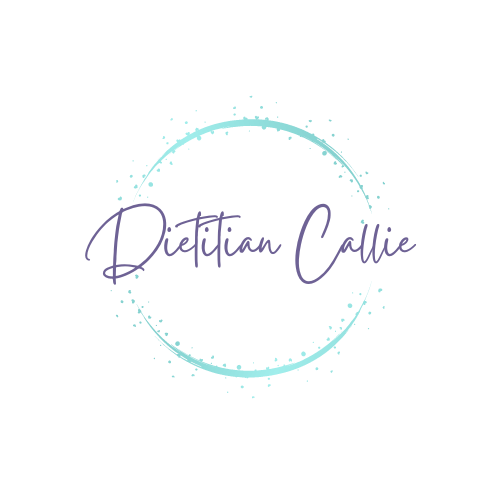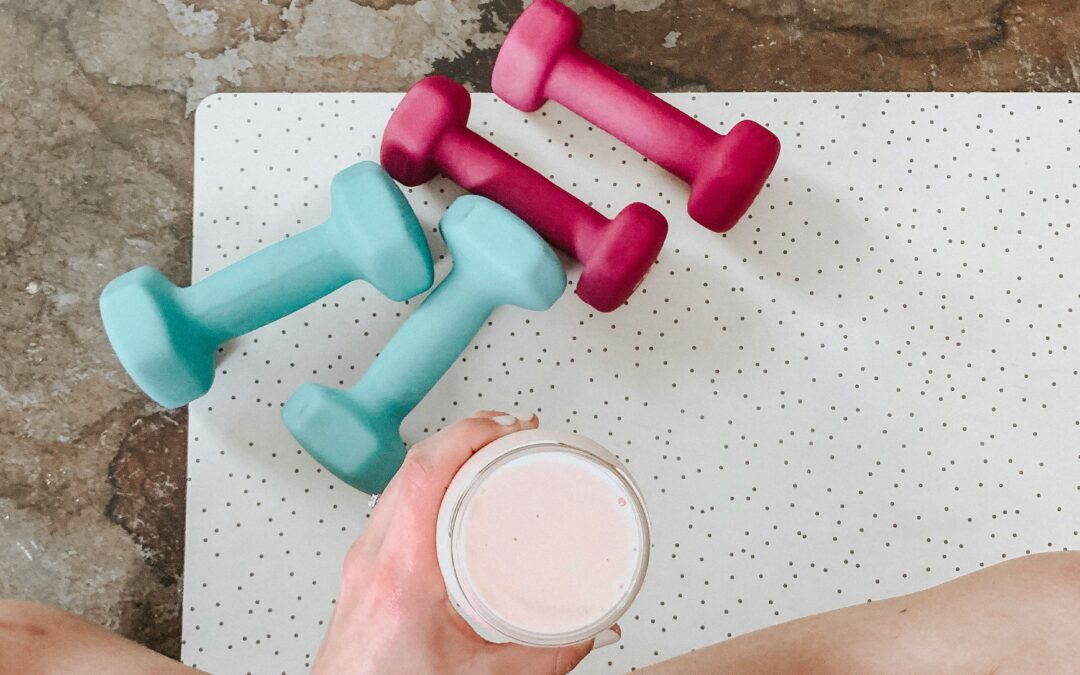You’ve probably heard about the term “cycle syncing” for a while now. The buzz of syncing your menstrual cycle to improve hormone health is making a presence on social media and the internet, touting benefits from improving hormone health to losing weight.
Cycle syncing is the practice of adjusting weekly nutrition and fitness routines to align with the different phases of the menstrual cycle. In basic terms, you adjust your eating routine and your exercise intensity depending on what phase you are in during your menstrual cycle.
The benefits to cycle syncing include improved menstrual cycle regularity, reduction in PMS (premenstrual symptoms), improved body composition, increased energy, and overall improved hormone balance.
Before we dive into how to cycle sync, you must first understand how the menstrual cycle works!
Understanding Your Menstrual Cycle
The first step to cycle syncing is to understand your menstrual cycle. When you know how hormones fluctuate throughout your cycle, the methods of cycle syncing make more sense. Below is an explanation of each phase, but you can also reference the graphic here:
Day one of your menstrual cycle is the day you start bleeding. Estrogen, progesterone, and testosterone are all at their lowest in the first few days of the follicular phase when you are bleeding.
Estrogen then makes a surge in the late follicular phase, which prompts the release of FSH (follicular stimulating hormone) and LH (luteinizing hormone), your fertility hormones that peak a little before ovulation. Ovulation is when a follicle is released and when fertility is at its prime.
After ovulation, estrogen drops and progesterone becomes the “star” of the luteal phase. Progesterone’s job is to ensure the uterus is ready to support an embryo if there is a successful pregnancy, which causes the progesterone surge. This surge in progesterone causes typical symptoms of increased appetite, change in mood, and weight fluctuations. If pregnancy is successful, progesterone remains elevated to support embryogenesis.
If no pregnancy occurs, progesterone drops which prompts the body to shed the uterine lining, which is your period. Testosterone remains relatively low compared to estrogen and progesterone in the cycle, but it does peak around ovulation.
Because of the fluctuations in these hormones, eating and exercising according to your menstrual cycle can be very helpful to support the ebbs and flows of estrogen, progesterone, and testosterone. It’s especially important if you are currently experiencing a hormone imbalance, such as endometriosis or PCOS!
Now that you have an understanding of how the menstrual cycle works, let’s dive into how you can sync your cycle with nutrition and fitness to improve hormone health! First up, how to cycle sync nutrition.
Cycle Syncing Nutrition
Menstrual Phase: Days 1-7
This is the bleeding phase of your cycle, and also where all of your hormones are at their lowest. Due to the bleeding and low energy from a drop in hormones, focus on adding more protein, fats, B vitamins, and iron-rich foods.
You may also find that your bowel movements are irregular at this time. This is due to the cramping causing more diarrhea. If this is the case, eat softer, cooked foods. For example, eat cooked veggies instead of raw until symptoms resolve. According to Chinese medicine, this phase is the “cooling phase” of your cycle, so eating more cooked, warm foods supports your hormones at this time.
Foods that support the hormones in the menstrual phase include:
- Beets
- Kale
- Blackberries
- Blueberries
- Watermelon
- Beans
- Flaxseeds
- Pumpkin seeds
- Buckwheat
- Wild rice
Follicular Phase: Days 7-12
This is the phase where your estrogen starts to surge before ovulation. This is often where you start to feel a little more like yourself again. A focus on fresh, vibrant, and light foods is key.
It’s also important to incorporate probiotic-rich and fiber-rich foods at this time to support estrolobome, which are the bacteria needed to metabolize excess estrogen from the body.
Foods that support the estrogen surge in the phase include:
- Avocado
- Citrus (lemon, lime, orange, grapefruit)
- Plum
- Pomegranate
- Lentils
- Peas (green, split, black-eyed)
- Brazil nuts
- Cashews
- Flaxseeds
- Pumpkin seeds
- Artichoke
- Broccoli
- Carrots
- Lettuce
- Parsley
- Zucchini
- Barley
- Oat
- Rye
- Wheat
Ovulatory Phase: Days 13-15
This is considered your high energy phase, where your estrogen peaks before ovulation. This peak makes you feel confident, and you tend to have a more balanced mood.
In Chinese medicine, this is considered the “hot phase” of the cycle due to the temperature increase that happens during ovulation. Eating more raw foods is encouraged due to the temperature increase.
Foods that support ovulation include:
- Quinoa
- Asparagus
- Bell peppers
- Brussels sprouts
- Chard
- Eggplant
- Spinach
- Tomatoes
- Apricots
- Cantaloupe
- Raspberries
- Strawberries
- Guava
- Lentils
- Almonds
- Flaxseeds
- Pecans
- Pistachios
- Pumpkin seeds
Luteal Phase: Days 16-28
This is the phase where progesterone starts to steal the show, and when PMS can start. It is also where your energy needs increase, which means you may need more calories and macronutrients.
Due to this surge in energy needs, this is often what causes more cravings. Your protein needs are also higher because high progesterone means higher amino acid needs. Rule of thumb, increase your protein intake by about 20 g or more per day to help with higher progesterone needs and reducing cravings.
Foods that support the luteal phase include:
- Brown rice
- Millet
- Cabbage
- Cauliflower
- Cucumber
- Garlic
- Ginger
- leeks
- Mustard greens
- Pumpkin
- Sweet potato
- Squash
- Apples
- Peaches
- Pears
- Bananas
- Pineapples
- Mangoes
- Chickpeas
- Sesame seeds
- Sunflower seeds
- Walnuts
Cycle Syncing Exercise
Menstrual Phase: Days 1-7
Focus on low-impact, steady-state, restful activities. The low hormone phase makes it hard to see a lot of performance gains. It’s important to work on bringing more oxygen to your muscles at this time.
The best activities for this phase include:
- Walking
- Yoga
- Pilates (mat Pilates specifically)
- Mobility
- Swimming
- Zone 1 or 2 cardio (low impact run/bike rides with low heart rate)
Follicular Phase: Day 7-12
Energy will start to increase in this phase. Focus on “waking the body” with some fun cardio and slightly harder workouts. This is where you can see gains in both aerobic and anaerobic gains.
The best activities in this phase include:
- Running/jogging
- Hiking
- Dancing
- Biking
- Cardio classes
Ovulatory Phase: Days 13-15
In this phase your estrogen and testosterone levels have peaked, giving you a big surge in energy. This is where you can focus more on performance gains and hard workouts.
The best activities in this phase include:
- Intervals/sprints (swim, bike, or run intervals)
- HIIT workouts
- Indoor cycling classes
- Bootcamp
- Kickboxing
- Zone 3-5 cardio (higher impact runs/bike rides)
Luteal Phase: Days 16-28
In the first half of this phase, your energy levels remain elevated. The second half of this phase as progesterone starts to increase and estrogen and testosterone decrease causes an energy drop. This is where you can really focus on lean muscle gain and focusing on quality over quantity workouts.
The best activities for the first part of the luteal phase include:
- Strength training
- Intense yoga/hot yoga
- Intervals
- HIIT training
- Bootcamp
The best activities for the second part of the luteal phase include:
- Walking
- Yoga
- Pilates (mat Pilates specifically)
- Mobility
- Swimming
- Zone 1 or 2 cardio (low impact run/bike rides with low heart rate)
REMEMBER: Listen to your body. When you sense the energy drop, it’s time to shift gears and do more low impact activity! It’s not saying to completely forget about exercise, it just means be okay with slowing down if your body is asking for it.
Common Barriers to Cycle Syncing
Although this is great information, sometimes it’s hard to put into practice (at first!). Some women want consistency with their workouts and nutrition, and that is perfectly fine! If this is the case, I often recommend just paying attention to energy shifts.
Don’t beat yourself up if you aren’t able to set a personal record in the gym, especially during your late luteal or menstrual phases. The key is to be mindful of energy shifts and avoid pushing yourself to limits that can make hormone imbalances worse.
Another key point is to pay attention to cravings and hunger, especially during the late luteal phase. If you notice a lot of hunger or sweet cravings, bump your protein intake up!
Where I often get questions is from women who are training for hard events, such as triathlons, crossfit, hyrox, or long distance running. This is where individualized coaching can help you come up with a plan that fits your needs specifically. I’m happy to help you come up with that plan and figure out what is best for you! Sign up to work with me here!
Another question I get is “how do you practice this when you’re absent from a period or on birth control?” That is a fantastic question. If you are on birth control, you can still practice this method if you know roughly when your period would start.
If your period is absent, whether it’s due to health conditions such as hypothalamic amenorrhea, RED-S, or post-menopause, the cycle syncing method can be tricky given you aren’t sure where you are at in your cycle. Working with a Registered Dietitian (like me!) can help you create a customized plan that fits your needs.
Oftentimes in these situations, we work on adding in nutrient-dense foods, ensure you are fueling with enough calories and macronutrients, and adjust training routines depending on your symptoms.
Key Takeaways
Cycle syncing is a tool that can help you balance your hormones, increase energy, and improve body composition. When we start cycle syncing we begin working with our hormones, not against them! Even small efforts to do this can improve symptoms, balance hormones, and skyrocket energy levels.
If the method seems too much, start with what’s most doable and comfortable! Or, work with me and I can help you create a customized plan that will help you achieve your health goals for good!

